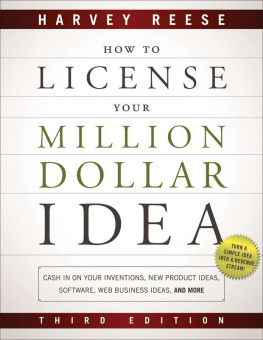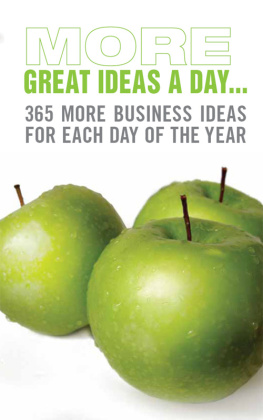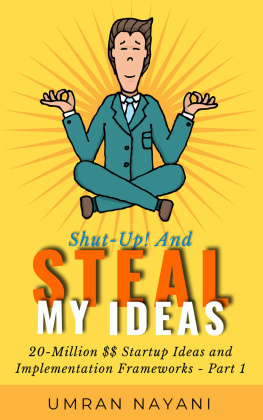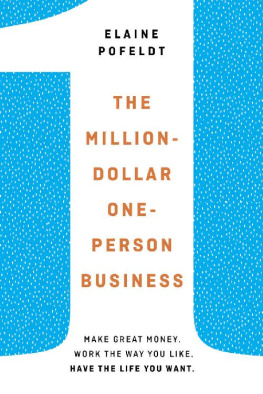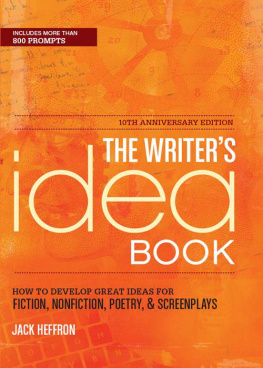Contents
Success is just a matter of luck. Ask any failure.
Earl Wilson

Copyright 2011 by Harvey Reese. All rights reserved.
Published by John Wiley & Sons, Inc., Hoboken, New Jersey.
Published simultaneously in Canada.
No part of this publication may be reproduced, stored in a retrieval system, or transmitted in any form or by any means, electronic, mechanical, photocopying, recording, scanning, or otherwise, except as permitted under Section 107 or 108 of the 1976 United States Copyright Act, without either the prior written permission of the Publisher, or authorization through payment of the appropriate per-copy fee to the Copyright Clearance Center, Inc., 222 Rosewood Drive, Danvers, MA 01923, (978) 750-8400, fax (978) 646-8600, or on the web at www.copyright.com . Requests to the Publisher for permission should be addressed to the Permissions Department, John Wiley & Sons, Inc., 111 River Street, Hoboken, NJ 07030, (201) 748-6011, fax (201) 748-6008, or online at http://www.wiley.com/go/permissions .
Limit of Liability/Disclaimer of Warranty: While the publisher and author have used their best efforts in preparing this book, they make no representations or warranties with respect to the accuracy or completeness of the contents of this book and specifically disclaim any implied warranties of merchantability or fitness for a particular purpose. No warranty may be created or extended by sales representatives or written sales materials. The advice and strategies contained herein may not be suitable for your situation. You should consult with a professional where appropriate. Neither the publisher nor author shall be liable for any loss of profit or any other commercial damages, including but not limited to special, incidental, consequential, or other damages.
For general information on our other products and services or for technical support, please contact our Customer Care Department within the United States at (800) 762-2974, outside the United States at (317) 572-3993 or fax (317) 572-4002.
Wiley also publishes its books in a variety of electronic formats. Some content that appears in print may not be available in electronic books. For more information about Wiley products, visit our website at www.wiley.com .
Library of Congress Cataloging-in-Publication Data:
Reese, Harvey.
How to license your million dollar idea: cash in on your inventions, new product ideas, software, web business ideas, and more/Harvey Reese.3rd ed.
p. cm.
Includes index.
ISBN 978-1-118-02242-9 (pbk); ISBN 978-1-118-08784-8 (ebk);
ISBN 978-1-118-08785-5 (ebk); ISBN 978-1-118-08786-2 (ebk)
1. Patent laws and legislationUnited StatesPopular works. 2. InventionsUnited States. I. Title.
KF3114.85.R44 2011
346.7304'86dc22
2011005892
Preface
If you are a reader of one of the previous editions of this book, I welcome you back. Youll find a great deal of fresh, helpful new material has been added to justify your revisit. All of the information, facts, and resources have been brought up to date, as have the contracts and forms in the Appendix. However, the real difference is this new editions expanded view of what constitutes a million dollar idea. Now that the electronics revolution is so well established as part of our everyday lives, it has opened up all sorts of wonderful new licensing opportunities for creative minds like yours that didnt widely exist when the former edition was published. But wow! They sure do now!
Its great if you have an idea for a new cookie cutter or a garden tool inventionbut you might just as easily have an idea for a new software application, or a new TV game show, or a new reality TV show, or even an idea for a new website business. Fresh and original ideas like these are no less valuable if properly prepared and placed in the right hands. A royalty check is still a royalty check, no matter what category of brilliant idea earned it.
However, if you want to run with the big dogs, you have to know what to do and how to do itand thats what this edition will show you. In addition to new instructional information for the more familiar kinds of product inventions, this new edition addresses these other types of intellectual property ideas as well, step by step, page by page, chapter by chapter. In most instances the essential process is almost identical. Whatever the idea, and allowing for each industrys special needs and requirements, the idea still has to be developed in a certain way, protected in a certain way, prepared in a certain way, and introduced in a certain way to the right people. There are ways to make that all happen and thats what this new edition is about.
If youre a new reader, I welcome you as welland offer my genuine congratulations.
The reason for the congratulations is that I know we wouldnt be meeting here if you didnt have a fresh and original new idea, and wanted to know how to cash in on it.
Youve come to the right place. This book has been published for many years in several editions and has earned the status of being the go-to source of information for folks like yourselffolks with great ideas (or who are looking for one) and who want to learn the right steps in order to be rewarded for them. Lots of people have fresh and original ideastheres nothing novel about thatbut what sets you apart is that youre taking action to make your own idea pay off for you. As Kit Carson said, referring to the pioneers great trek westward, The cowards wont start and the weak will die along the trail. Clearly that doesnt refer to you.
Inventors who have interesting and commercially viable new ideas or inventions find that they usually have three options. Option one is to use their original idea as the basis for starting a business. While this option clearly offers the biggest profit potential, it presents the biggest risks as well. Most folks dont take this choice, either because the idea doesnt lend itself to self-marketing or because they dont have the money or the access to money to bankroll the venture. Even if they have the money, they dont want to take the financial risk, or they dont feel they have the aptitude for being an entrepreneur. Or they may simply like their job and their lifestyle as they are and arent interested in the kind of earth-shaking changes that entrepreneurship carries with it.
The second choice is to find an interested buyer and sell your idea outright. This might be a good choice for the person who has a need for instant cash, but its likely to be the least profitable option. Since the purchaser cant know for sure how valuable the offering might be, the idea will be grossly undervalued to minimize the risk, and the seller will often wind up with far less than the idea is worth. The classic example is when Stanley Weston, the fellow who developed the G.I. Joe idea, sold it outright to the Hasbro Toy Company for $100,000, thinking he made a wonderful deal for himself. If he had licensed the idea instead of selling it, the thousands would have been millions.
Which brings us to the third and most popular option: licensing. The inventor gives or lends the production and marketing rights for his new invention or idea to a company in the appropriate business, which in turn pays the inventor a small percentage for every product sold. All the risk is borne by the licensee, the inventors financial expenditure is usually modest, the interruption in the inventors lifestyle is little more than a speed bump, and the income is passive, meaning once the deal is made, the inventor moves on to other things and the royalty checks come in automatically every month.
Since licensing is far and away the most popular option, thats what this book is dedicated to. Ive been in this business for years and years, and if I cant show you what to do and how to do it, I dont know who can. Step by step, what to do first and what to do next, I will give you my secrets for what I know worksright up to the point where you leave the licensees office with a smile on your face, a contract in your pocket, and a check in your hand. Big licensing deals are made every day by just regular folks with great ideas and who have the knowledge, grit, and determination to see it through. So what are we waiting for? Lets get started!
Next page
